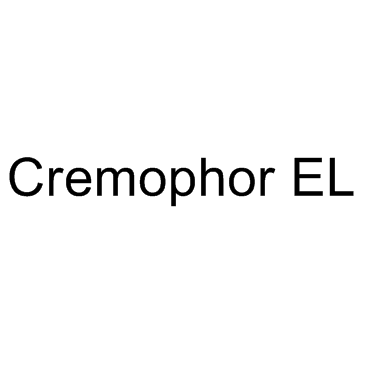Cremophor EL

Cremophor EL structure
|
Common Name | Cremophor EL | ||
|---|---|---|---|---|
| CAS Number | 61791-12-6 | Molecular Weight | 172.010 | |
| Density | 1.4±0.1 g/cm3 | Boiling Point | 305.7±32.0 °C at 760 mmHg | |
| Molecular Formula | C4H7Cl2NO2 | Melting Point | 4°C | |
| MSDS | Chinese USA | Flash Point | 138.7±25.1 °C | |
Use of Cremophor ELCremophor EL is a polyethoxylated surfactant. |
| Name | 1,3-Dichloro-2-propanyl carbamate |
|---|---|
| Synonym | More Synonyms |
| Description | Cremophor EL is a polyethoxylated surfactant. |
|---|---|
| Related Catalog | |
| In Vitro | Cremophor EL is a widely used excipient. In the first 10 h, Cremophor EL at 5 mg/mL increases the impedance, then decreases it, and after 20 h of treatment, epithelial cell death is detected. Cremophor EL decreases cell viability and increases cell toxicity more than RH40. Both epithelial viability and monolayer integrity are seriously impaired at 10 to 50 mg/mL concentrations of Cremophor EL at 24-h treatment. Cremophor EL also enhances cell detachment[1]. |
| Cell Assay | Cell viability is determined by double fluorescent staining: bis-benzimide labels all cell nuclei, ethidium-homodimer-1 stains only dead cells. For morphological examinations, primary brain endothelial cells with tight barrier properties are used. Cells grown on glass coverslips are treated with Cremophor EL and RH40 for 1 and 24 h. Cremophor EL and RH40 are tested at 0.1 to 50 mg/mL concentrations. Triton X-100 detergent (10 mg/mL) is used in toxicity assays as a reference compound to cause cell death[1]. |
| References |
| Density | 1.4±0.1 g/cm3 |
|---|---|
| Boiling Point | 305.7±32.0 °C at 760 mmHg |
| Melting Point | 4°C |
| Molecular Formula | C4H7Cl2NO2 |
| Molecular Weight | 172.010 |
| Flash Point | 138.7±25.1 °C |
| Exact Mass | 170.985382 |
| LogP | 0.62 |
| Appearance of Characters | Viscous Liquid | Clear yellow |
| Vapour Pressure | 0.0±0.6 mmHg at 25°C |
| Index of Refraction | 1.481 |
| Storage condition | REFRIGERATOR (+4C) |
| Personal Protective Equipment | Eyeshields;Gloves |
|---|---|
| Hazard Codes | Xn |
| RIDADR | NONH for all modes of transport |
| WGK Germany | 1 |
| RTECS | GO5661000 |
|
Numb is required to prevent p53-dependent senescence following skeletal muscle injury.
Nat. Commun. 6 , 8528, (2015) Regeneration relies on coordinated action of multiple cell types to reconstitute the damaged tissue. Here we inactivate the endocytic adaptor protein Numb in skeletal muscle stem cells prior to chroni... |
|
|
Formulation and biopharmaceutical evaluation of silymarin using SMEDDS.
Arch. Pharm. Res. 30(1) , 82-9, (2007) Silymarin has been used to treat hepatobiliary diseases. However, it has a low bioavailability after being administered orally on account of its low solubility in water. In order to improve the dissol... |
|
|
Preparation and evaluation of self-nanoemulsifying tablets of carvedilol.
AAPS PharmSciTech 10(1) , 183-92, (2009) The purpose of this study was to combine the advantages of self-nanoemulsifying drug delivery systems and tablets as a conventional dosage form emphasizing the excipients' effect on the development of... |
| MFCD00130879 |
| 1,3-Dichlor-2-propanylcarbamat |
| Carbamate de 1,3-dichloro-2-propanyle |
| 2-Propanol, 1,3-dichloro-, carbamate |
| 1,3-dichloropropan-2-yl carbamate |
| 1,3-Dichloro-2-propanyl carbamate |
| Castor oil ethoxylated |
| Polyoxyethylene castor oil |

